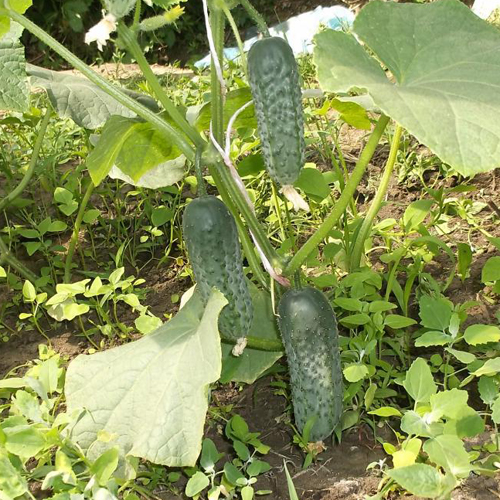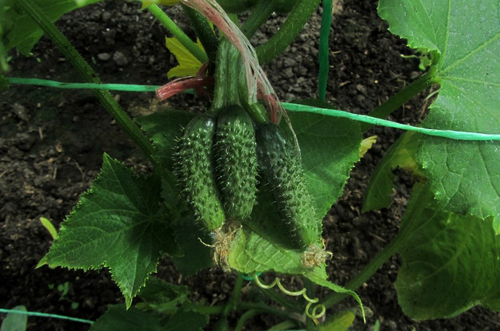Cucumber variety Zador (F1)
When choosing cucumber varieties for greenhouses, you should opt for parthenocarpics, which do not depend on the presence of pollinating insects and tie crops even in closed greenhouses. And in the open field, such crops show good results in the cold summer period, when bee-pollinated species cannot bear fruit normally. Such universal varieties include a cucumber with an optimistic name Zador. Originator - LLC "Selective station im. N.N. Timofeeva ". The variety was entered into the State Register of Breeding Achievements of Russia in 2008 with admission in all regions of the country. It can be cultivated in open ground and under film shelters in personal subsidiary plots. Due to the combination of suitable characteristics, our hero is suitable for industrial cultivation. It is a hybrid, therefore it is labeled F1.

Description
The plant is indeterminate, with medium vigor, medium-growing, stepchildren grow very slowly. Leaves are long-petiolate, medium-sized, green, whole, angular-cordate, with a slightly wrinkled surface. The flowering type of the variety is female. In the leaf node, from 2 to 5 ovaries are formed.
The fruits of Zador are short, gherkin type, cylindrical, slightly ribbed. Greens ready for picking are 8 - 10 cm long. The skin is not thick, elastic, green in color, with light stripes up to half the length of the cucumber. The surface is coarse, tubercles are often located, pubescence is light, of medium density. The pulp is tender, crispy, without bitterness. The State Register describes the taste as good. The seeds are in the stage of milky ripeness, so they are practically not felt during consumption. Hollowness in cucumbers has never been noticed. The average mass of greens is 75 - 85 grams. The fruits are favorably distinguished by their high commercial qualities.
Variety characteristics
- The duration of the period from full germination to the beginning of fruit collection in the Zador hybrid is 38 to 42 days. Such early maturity allows the use of the culture in an extended turnover;
- The marketable yield is described differently. So, the State Register gives data on 5.2 kg in open ground and 16.2 kg per 1 square meter in film unheated greenhouses. "Semko" promises 12 kg per 1 sq. meters in the open field and 15 kg from the same area in the greenhouse. The originator claims 2 kg of cucumbers per plant;
- the fruiting process proceeds smoothly, without visible undulating periods;

- you will have to harvest the crop often in order to prevent overgrowth of cucumbers and redirect food to the ovaries that are just beginning to fill;
- outgrowing the optimal size, cucumbers not only gain more weight, their skin becomes rough and thick;
- Zador's immunity, like all hybrids, is quite high. Resistance to the main enemy of the cucumber culture, powdery mildew, is noted. Also, the plant is tolerant to downy mildew, resists anthracnose, bacteriosis and olive spot;
- parthenocarp provides a stable yield of the variety, regardless of the whims of nature;
- transportability is very good, in the process of transportation Zelentov does not suffer from appearance. Subject to storage standards, keeping quality can be long-term without compromising taste;
- the way of use is universal. An early vegetable is good in its natural form, suitable for salads. Small size, thin skin and dense flesh make cucumbers suitable for canning; under the influence of temperatures, the fruits do not lose their crispness.
Agrotechnics
Cultivation of Zador can be carried out by direct sowing of seeds into the soil or by means of seedlings.The second method is the most profitable and economical. Seeds are sown for seedlings in late April - early May. 25-day-old seedlings can already be transplanted under film shelters. The recommended planting density is 2.5 pieces per 1 square meter in a greenhouse or according to the scheme: (90 + 50) x 40 cm.On the beds with a single-line planting - 70 × 30, with a two-line planting - (90 + 50) x 25 cm.After transplant the plant is tied to a trellis. Leaving is facilitated by the rather inactive rate of regrowth of the stepsons. During the growing period, the variety requires a sufficient amount of moisture, periodic fertilization and keeping the soil clean.
The Zador hybrid is interesting for its early maturity and resistance to major diseases of the culture. Subject to agricultural techniques, the yield of cucumber is quite decent, which, combined with the suitability for canning, will help provide family with harvests in the winter. Leaving has no pronounced nuances, so even a novice gardener can take up the cultivation of our hero. But with all the obvious advantages, there are also disadvantages. If the greenery overgrows, the skin will become rough. For further cultivation, seeds will have to be purchased annually.








